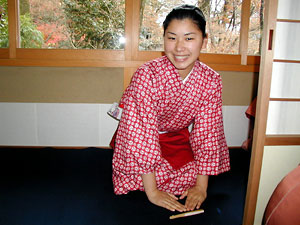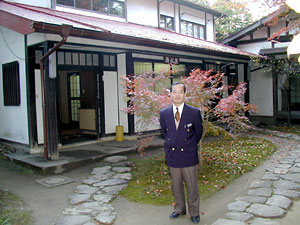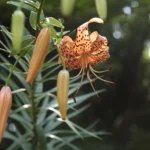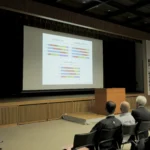By Bill Roberts
Yasushi Hiraoka and Kei Shibahara will graduate in March from Baishojuku, Oomoto’s seminary in Kameoka for young adults. Their reasons for entering the rigorous school and their goals when they leave could not be more different.
“I feel the obligation to do something for God,” says Hiraoka, 27, who had a profound spiritual awakening nearly three years ago that caused him to drop music school and a promising business career to enter Baishojuku. The experience also left him with the desire to devote his life to God through a career at the Oomoto Foundation.
Miss Shibahara, on the other hand, resisted her father for two years after high school before entering Baishojuku to please him. Her future lies outside Oomoto. “I would like to go back to computers,” says Miss Shibahara, 21, who trained in computers during two years of college. “My father wants me to work at Oomoto but no thank you.”
Neither case surprises Headmaster Kenji Tanabe, a professional photographer and former Baishojuku student. For men, who must enter by the age of 30, the school offers a one-year course and a three-year course. “The men who do the three-year course usually stay and work at Oomoto,” says Tanabe, headmaster for two years. About half the women, who must start by age 25, work at Oomoto after finishing their two-year course, he adds.
(Tanabe and the two students were interviewed through an interpreter.)
Like most seminaries, Baishojuku emphasizes the study of scripture, doctrine and the rituals of the faith. Students also study Esperanto, an artificial language based on European tongues, which Oomoto Co-Founder Onisaburo Deguchi adopted because he believed one universal language would help lead to the unified world prophesized in his revelations.
Unlike other seminaries, Baishojuku also offers students the chance to learn traditional Japanese arts, which are fundamental to Oomoto. Men and women study calligraphy, ceramics, poetry, Noh dance, martial arts, gardening and farming. Women also study the koto (Japanese harp), kimono making, flower arranging and cooking. Men spend more time than the women on martial arts and farming. They all study the art Oomoto emphasizes most: Tea ceremony. “It has been a pillar of the school from the beginning,” says Tanabe.





The ever flowering but unchanging mind
Learning the traditional arts is one goal of the school. Others include: Learning the teachings of Oomoto so students can contribute to the religion’s goal of building a new age; cultivating the inner heart, and developing the practice of self reflection.
Another goal is implied by the name, Baishojuku. “Bai” means plum and “sho” means pine. (“Juku” means boarding school.) The plum is the first tree to flower in spring; pine needles never change color. The goal is to develop the mind of “baisho,” a mind that is ever flowering yet unchanging in essential characteristics such as honesty.
Despite her initial resistance, Miss Shibahara now thinks attending Baishojuku was a good idea. “The things I learned here nourish me.” She counts among the lessons greater ease around adults, the ability to keep a positive outlook, and the tea ceremony. Tea ceremony is the one art she hopes to continue to study, she says.
Miss Shibahara, a second-generation Oomoto member, was homesick and depressed during her first year. “I cried every night to go home,” she says. She doesn’t recall when or why things changed. The worst part was the first 100 days.
Called 100 Days of Spiritual Discipline, they are no picnic for anyone. The new students are not allowed to leave the Oomoto compound. They cannot smoke, drink alcohol, eat sweets, read newspapers, magazines and books, or watch TV and listen to radio. There is no communication with family and no contact with students of the other sex.
Why? “It is an effort to separate the student from the life they were leading when they first came to the school,” says Tanabe. “It seems to be especially hard on the women. I think the no sweets and no tobacco are the most difficult aspects for everyone.”
The school has a 10-percent dropout rate in the first year, however no more during the first 100 days than at any other time, he adds. Those who make it through the first year inevitably stay and finish the rest of their course.
An unexpected spiritual awakening
Hiraoka was apprehensive about the first 100 days. “I didn’t think I could survive,” he recalls. “I thought the people here must be very special people.”
He did survive, of course. What most surprises Hiraoka, a third-generation member of Oomoto, is that he entered at all. He had a degree in business management from Konan University near Kobe, had worked as a manager in a temporary employment agency, and had just finished a year of music school. During the summer break from music school, he attended a five-day preliminary seminar on Baishojuku because his mother suggested it and he had nothing else to do. He had no intention of entering Baishojuku.
During the opening religious ceremony for the seminar, Hiraoka had what can only be described as a spiritual awakening. As he listened to the teachings he suddenly felt warm all over his body. He began to cry for no apparent reason and, in his words, sensed the existence of God. “I realized for the first time in my life that I had been protected by God since I was born,” he recalls. “I felt supported by God.”
From this feeling came his immediate desire to do something for God. “On the first night of the seminar I called my mother to tell her my plan to join the school,” he says. “She was surprised and also very happy.”
When he completes his program in March 2002, Hiroaka will take two weeks off then go to work at Oomoto. All men who graduate are qualified as priests, but that is not his main interest. He is most interested in the editorial and international departments but wherever he starts will be fine. “Right now I want to experience as many different departments as I can,” he says.
Keeping up with the times
Most young people do not have the kind of experience that preceded Hiroaka’s decision. And from the outside, the school looks old fashioned and tough. Days begin at 5 AM and often last until 10 PM or later. Dating is not permitted. Long periods are spent in prayer, meditation and studying doctrine.
Consequently, the school has few students. Only 12 at present, says Tanabe. Since it was founded in 1967, it has less than 350 graduates. There were 48 students when Tanabe attended 25 years ago and he senses there must be things Baishojuku could do to keep up with the times. But the basic principles and curriculum cannot change.
Tanabe has tried a thing or two. He allowed the students to practice with electric guitars and other modern instruments for one month then perform popular music. One caveat: They had to translate the songs and sing them in Esperanto. Hiraoka led a rock band that pounded out three tunes, including two Beatles numbers.
Hiraoka believes the school has a bad image that would dissolve for many young adults if they would just attend one of the preliminary seminars like he did. He doesn’t think anything the school asks students to do is hard. “Whether we spend the day studying tea ceremony or making tea bowls, I can enjoy it. That’s the difference. Some people have a hard time here because they don’t enjoy what they’re doing.”
Hiraoka has developed a special liking for the Noh dance. “This was a subject I was not interested in at all before I came to the school,” he recalls. “I now realize how wonderful these dances are. I want to continue to do these dances for the rest of my life.”



